Disclosure: This article contains affiliate links. We may earn a commission from purchases at no extra cost to you, which helps our travel content.
The Land Cruiser's tires crunched over the salt-crusted sand as I gazed at the skeletal remains of shipwrecks dotting Namibia's haunting coastline. This marked the beginning of my most ambitious African adventure yet—a 3,000+ kilometer overland journey from the desolate beauty of the Skeleton Coast to the vibrant shores of Lake Victoria. After five previous trips to the continent, I was finally tackling my dream route through Namibia, Zambia, and Tanzania, connecting some of Africa's most dramatic landscapes and diverse cultures by road. Grab your maps and join me on this epic month-long expedition that will challenge your driving skills, expand your cultural horizons, and deliver the adventure of a lifetime.
Preparing for Africa's Ultimate Road Trip
When my friend Lucia (a fellow legal assistant with an equally intense wanderlust) agreed to join this expedition, we spent three months meticulously planning our route. This isn't your typical holiday—crossing three countries by road requires serious preparation.
First, vehicle selection. After researching extensively, we opted for a Toyota Land Cruiser rental with roof tents, extra fuel tanks, and comprehensive insurance. While not cheap at roughly $120/day, this beast handled everything from deep sand to rocky mountain passes without complaint.
Documentation proved equally crucial. Beyond passports with at least 8 empty pages, we needed international driving permits, vehicle insurance covering all countries, carnet de passage (vehicle passport), and yellow fever certificates. Border crossings in Africa require patience and preparation—I kept all documents organized in a waterproof travel document organizer that proved invaluable during unexpected downpours.
For navigation, I downloaded offline maps on both Garmin inReach Explorer+ (which also served as our emergency satellite communicator) and Maps.me. Cell service exists mainly near towns, so don't rely solely on your phone.
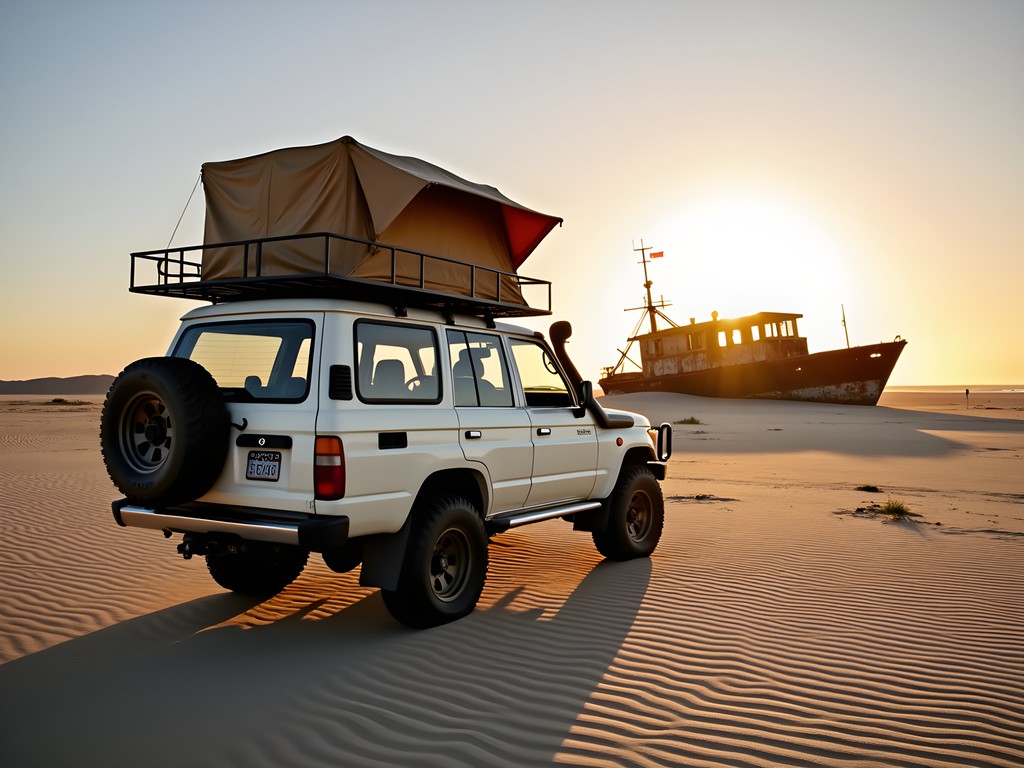
💡 Pro Tips
- Book your 4x4 at least 3 months in advance during high season (June-October)
- Carry multiple copies of all vehicle documentation—officials often keep copies at border crossings
- Learn basic vehicle maintenance including changing tires and checking fluids before departure
Namibia's Skeleton Coast to Etosha: Desolation to Abundance
The journey's first leg took us through landscapes so contrasting they seemed from different planets. The Skeleton Coast—aptly named for its shipwrecks and whale bones—is a 500km stretch where the Namib Desert meets the Atlantic. Morning fog shrouded the beach as we drove northward from Swakopmund, creating an eerie backdrop for the rusted remains of vessels claimed by these treacherous waters.
After two days navigating this coastal wilderness (permits required and arranged in advance), we turned inland toward Damaraland. The transformation was gradual but stunning—ochre desert giving way to rocky outcrops where desert-adapted elephants roam. We spent a night wild camping near Twyfelfontein, falling asleep to distant lion roars after exploring ancient rock engravings by day.
By day five, we reached Etosha National Park, where the landscape shifted dramatically again to vast salt pans and savanna teeming with wildlife. Self-driving through Etosha offers unparalleled freedom—we spent sunrise to sunset tracking herds of elephants, zebras, and witnessing three lionesses on a successful hunt. The Nikon Monarch 7 binoculars I brought proved invaluable for spotting distant wildlife while keeping a safe distance.
Camping inside Etosha at Okaukuejo provided the trip's most magical moment: watching rhinos, elephants and giraffes visit the floodlit waterhole just steps from our campsite as stars blanketed the African sky.

💡 Pro Tips
- Get your Skeleton Coast permit at least 2 months in advance—they limit daily entries
- Fill all fuel tanks before entering remote areas; stations can be 400+ km apart
- In Etosha, early morning (6-9am) and late afternoon (4-7pm) offer the best wildlife viewing
Crossing Borders: Navigating Zambia's Wilderness
Leaving Namibia, we faced our first major border crossing at Katima Mulilo. Despite arriving early, the process took nearly three hours—a lesson in African patience. Tip: bring small US dollar bills for various 'fees' that mysteriously appear during these crossings.
Zambia's roads marked a dramatic shift from Namibia's well-maintained network. Potholes became our constant companions as we navigated toward Livingstone, home to the magnificent Victoria Falls. Here, we splurged on two nights at a proper lodge to shower, recharge devices, and reorganize gear after a week of camping. The thundering 'Smoke that Thunders' lived up to its reputation—we spent a full day exploring viewpoints and getting drenched in the spray.
From Livingstone, we ventured northeast through Zambia's interior, where tourism infrastructure thins considerably. Villages replaced towns, and our progress slowed to sometimes just 200km daily. This region demanded our most crucial piece of equipment: a water purification system that converted river and borehole water into safe drinking supply.
The reward for these challenging roads? Pristine wilderness and authentic cultural exchanges. In a small village near Kasanka National Park, we were invited to a local gathering where I joined women pounding cassava—my pathetic attempts causing uproarious laughter that bridged any language barriers.
Kasanka itself offered a magical wildlife experience without Etosha's crowds. Though smaller, its wetlands host incredible birdlife and the world's largest fruit bat migration (October-December). Our campsite beside the Luwombwa River became my favorite overnight stop—hippos serenaded us with their distinctive honking laughs throughout the night.
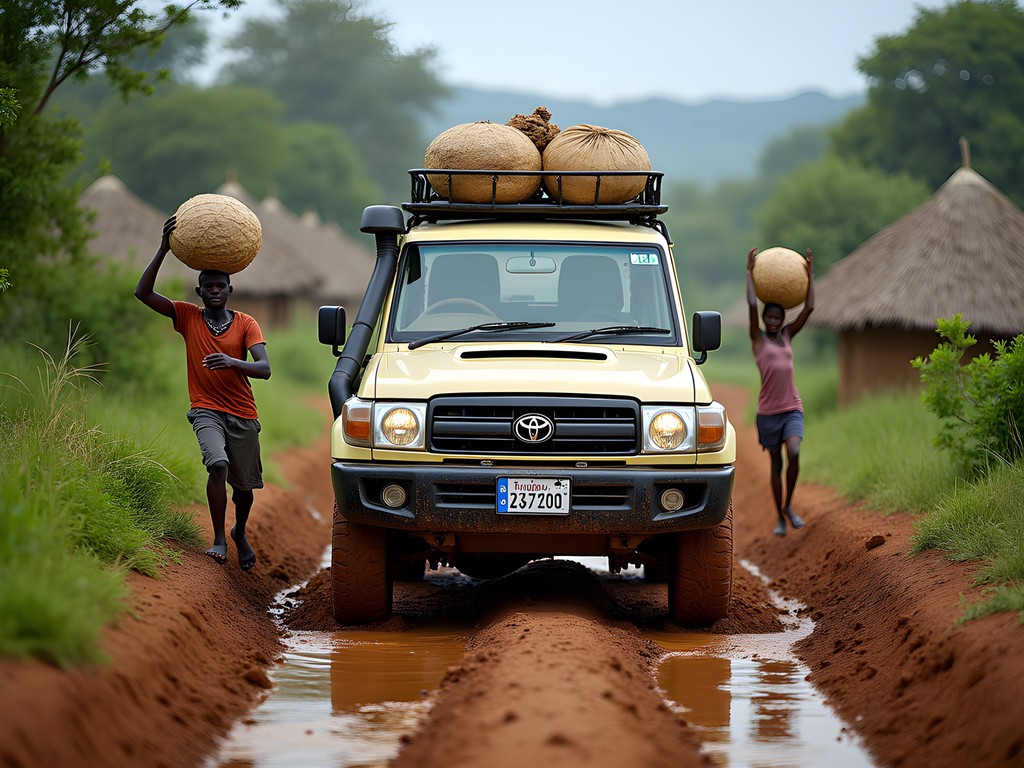
💡 Pro Tips
- Budget extra time for border crossings—they rarely take less than 2 hours
- Carry printed copies of accommodation bookings; immigration often wants to see where you're staying
- Download iOverlander app for up-to-date road conditions and border crossing reports
Tanzania's Western Corridor: The Road to Lake Victoria
The Tanzania border crossing near Tunduma tested our patience further—six hours of shuffling between offices, filling forms, and negotiating various 'processing fees.' Pro tip: download and pre-fill Tanzania's visa application to save precious time.
Once through, Tanzania's southern highlands delivered breathtaking scenery and a welcome climate change. Cooler temperatures and verdant mountains replaced Zambia's heat as we wound our way toward Lake Victoria. We detoured to Ruaha National Park, where the compact safari camera I'd been testing captured incredible close-ups of leopards and elephants against dramatic kopje landscapes.
As we pushed northwest, roads deteriorated again. What Google Maps optimistically suggested would be a six-hour drive stretched to eleven bone-jarring hours. The compensation? Passing through regions few tourists ever see, where children ran alongside our vehicle in excitement and every stop attracted friendly crowds curious about our journey.
After three challenging weeks on the road, the first glimpse of Lake Victoria's vast blue expanse felt like a mirage. We'd traversed nearly the width of the African continent, from the Atlantic-kissed deserts of Namibia to this immense inland sea.
Our final destination, Mwanza, revealed a bustling lakeside city where we celebrated with fresh tilapia at a local restaurant overlooking the water. The distinctive rock formations jutting from the lake (inspiration for Pride Rock in The Lion King, according to locals) provided a perfect backdrop for reflection on our epic journey.
The final night, we splurged on a lakeside hotel in Mwanza, where I soaked my travel-weary body in a proper bath for the first time in weeks. From my balcony, fishing boats dotted the sunset-painted waters—a peaceful conclusion to our 3,000-kilometer adventure across three of Africa's most captivating countries.
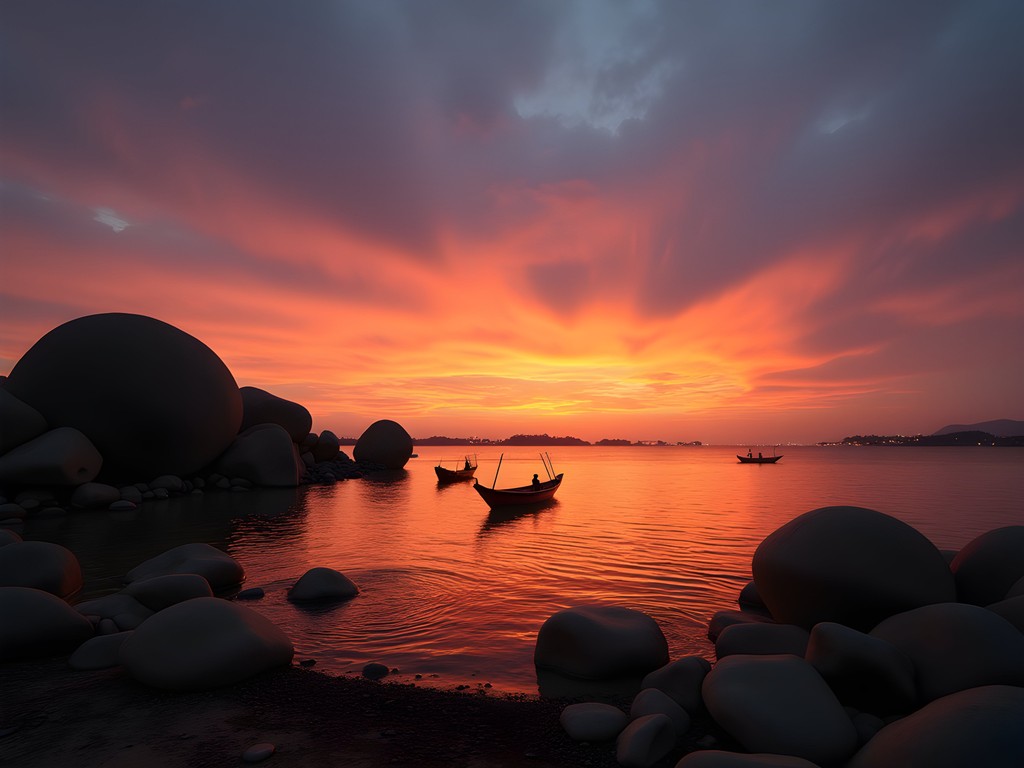
💡 Pro Tips
- Tanzania's roads are notoriously rough—add 50% to Google Maps time estimates
- Carry a spare vehicle air filter; Tanzania's dusty roads clog them quickly
- Download Tanzanian shillings currency converter app—many remote areas don't accept cards or dollars
Practical Logistics: Fuel, Accommodation & Safety
Successfully completing this route requires careful logistical planning. Fuel management topped our daily priorities—I maintained a detailed log of kilometers traveled and fuel consumed, never letting our tank drop below half-full. The longest stretch without fuel was 380km in northern Namibia, though our auxiliary tank provided peace of mind.
Accommodation varied wildly. We camped 22 of our 30 nights, alternating between established campgrounds with facilities and wild camping in remote areas (legal in many parts of these countries with proper permits). Our rooftop tent proved worth every penny—quick to set up and keeping us safely above ground in wildlife-rich areas. For the remaining nights, we chose mid-range lodges strategically placed for proper showers and rest.
Safety concerns often dominate conversations about African travel, but our experience was overwhelmingly positive. Common-sense precautions served us well: we never drove after dark, kept valuables hidden, and always informed someone of our route. The satellite communicator provided crucial emergency backup in areas without cell service.
Food planning required creativity. We carried a dual-zone portable refrigerator powered by the vehicle that kept essentials fresh. Local markets provided vegetables, fruits and bread, while we relied on longer-lasting staples (rice, pasta, canned goods) for remote stretches. Some of our best meals were simple pasta dishes cooked on our camp stove as elephants trumpeted in the distance.

💡 Pro Tips
- Never pass a fuel station without topping up, regardless of your current level
- Invest in good-quality camping gear—it's your home for a month in challenging conditions
- Learn key phrases in local languages—'hello,' 'thank you,' and 'beautiful country' open many doors
Final Thoughts
As our flight lifted off from Mwanza's small airport, I pressed my face against the window for a final glimpse of Lake Victoria shimmering below. This journey across southern Africa's vast wilderness had been more than just an adventure—it was a masterclass in patience, adaptability, and cultural connection. From the haunting shipwrecks of the Skeleton Coast to the vibrant fishing communities of Lake Victoria, we'd traversed environments so diverse they defied imagination.
This route isn't for everyone. It demands mechanical knowledge, comfort with uncertainty, and the ability to problem-solve far from help. Yet for experienced travelers willing to embrace the challenges, the rewards are immeasurable: nights under star-filled skies untouched by light pollution, conversations with villagers rarely visited by outsiders, and the profound sense of accomplishment that comes from navigating one of Earth's most magnificent continents on your own terms.
As I plan my next African adventure (the Western Africa coastal route is calling), I'm already nostalgic for those long, dusty days behind the wheel, where the journey itself—not just the destinations—created the most enduring memories. If you're ready for the ultimate self-drive adventure, this Skeleton Coast to Lake Victoria route offers a perfect blend of challenge, beauty, and transformation. Buon viaggio, fellow adventurers!
✨ Key Takeaways
- This 3,000km route requires extensive preparation but delivers unparalleled access to authentic Africa
- A reliable 4x4 vehicle with camping equipment is essential for the challenging terrain and remote locations
- Border crossings demand patience, preparation and extra documentation
- The dramatic landscape transitions—from desert to savanna to highlands to lakeshore—make this one of Africa's most diverse road trips
📋 Practical Information
Best Time to Visit
May-October (dry season)
Budget Estimate
$5,000-7,000 per person for 30 days (including vehicle rental)
Recommended Duration
Minimum 3-4 weeks
Difficulty Level
Advanced - Requires 4x4 Experience And Self-Sufficiency

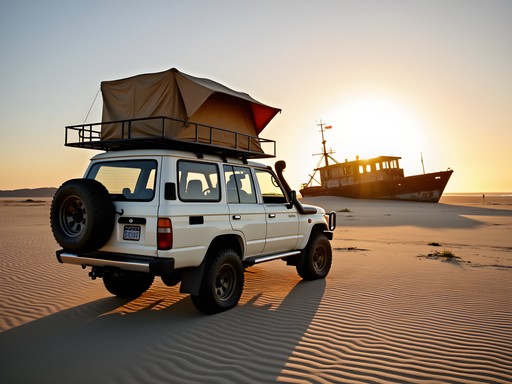

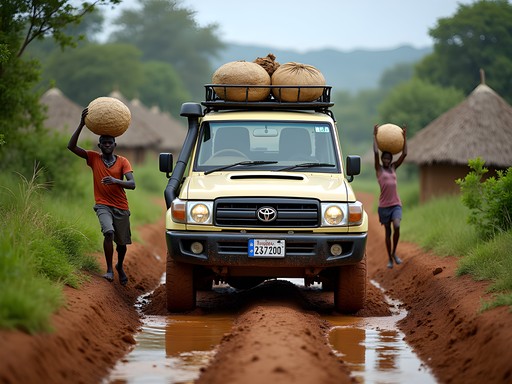

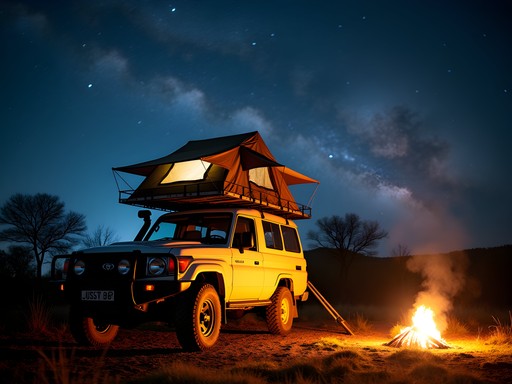


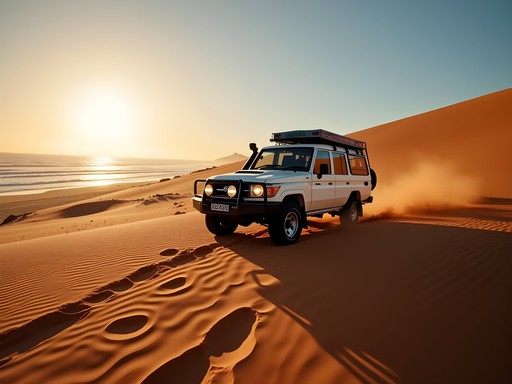
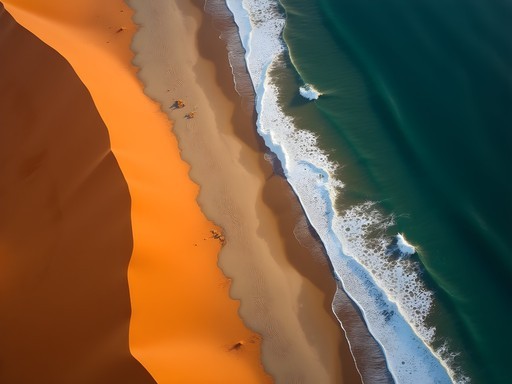
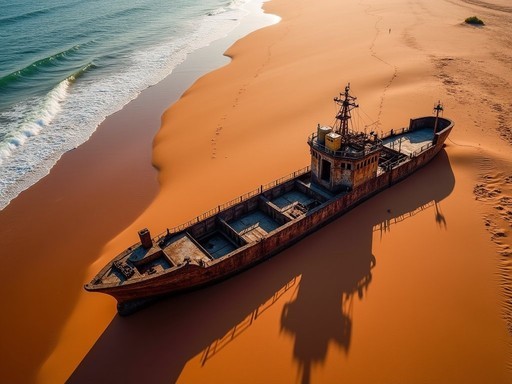




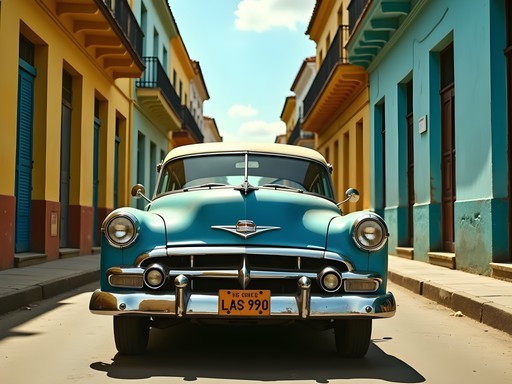
Comments
Douglas Bradley
This comprehensive route analysis is exactly what the overland community needs. I particularly appreciated your detailed breakdown of the border crossing procedures between Namibia and Zambia - those are notoriously challenging. One element I'd add from my experience last year: the Western Corridor of Tanzania has seen significant road improvements, but the section between Kahama and Mwanza still requires careful navigation during the rainy season. I found my GPS unit invaluable for tracking alternate routes when main roads became impassable. Your wildlife photography at Etosha is exceptional - what lens setup were you using for those night waterhole shots?
Skylar Bryant
Thanks for the additional insights on the Western Corridor, Douglas! You're right about those road conditions - timing is everything. For the night shots at Etosha, I was using a Sony 100-400mm GM with a 1.4x teleconverter on an A7IV body. The lit waterholes there are such a gift for photographers!
happyblogger
Bucket list material right here! Those Etosha wildlife shots are incredible!
vacationway
This looks amazing! Planning my first Africa trip next year. Would you recommend renting a vehicle or joining a tour for someone with zero experience in Africa?
Skylar Bryant
For a first-timer, I'd definitely recommend a guided tour, especially for the Skeleton Coast. The navigation can be tricky and having local knowledge is invaluable. Once you get comfortable with Africa, self-driving is incredible for the freedom it offers!
Douglas Bradley
I'd second Skylar's advice. My first Africa trip was with a guide, and by my third visit I felt confident enough to self-drive. The learning curve is worth it though - nothing beats the freedom of your own schedule in these vast landscapes.
roamguide
Those shipwreck photos are haunting! Great post.
springqueen
WOW! This journey looks INCREDIBLE! The contrast between the desolation of Skeleton Coast and the abundance of wildlife at Etosha is exactly what makes Africa so magical. I did a similar route last year but went through Botswana instead of Zambia. Those shipwrecks are hauntingly beautiful - did you get to see the Eduard Bohlen? That half-buried ship was one of my favorite photography spots ever!
Skylar Bryant
Thanks springqueen! Yes, I did see the Eduard Bohlen - truly otherworldly how it sits there half-buried in the sand. The Botswana route must have been amazing too. Did you go through the Okavango?
springqueen
I did! Spent 3 days in a mokoro canoe through the Delta - life changing! Your Zambia route looks equally epic though. Love how you captured those border crossing tips!
Kimberly Murphy
What an epic journey, Skylar! I did a similar route last year but in reverse - started at Lake Victoria and worked my way down. The Western Corridor of Tanzania was the highlight for me too - those roads were brutal but the villages and people were amazing. One tip for anyone planning this: I used my satellite messenger daily as cell coverage was non-existent for days at a time. Worth every penny for safety and peace of mind, especially when camping in remote areas. Did you encounter any issues with fuel quality in the rural areas? I had to filter diesel a couple times in western Tanzania.
Skylar Bryant
Thanks Kimberly! Fuel quality was definitely hit or miss. We carried extra filters and actually had to use them twice. The worst was near the Zambia/Tanzania border where we got some seriously dodgy diesel that would have caused problems for sure.
freewalker
Just finished reading this and wow - brought back memories of my Namibia trip last year! Though I only did the northern part, not the full epic journey you did. The Skeleton Coast is something else, right? Those shipwrecks look exactly like I remember them. How many spare tires did you carry? We had two flats in just one week on those gravel roads!
islandlife
Those shipwrecks are incredible! Adding this to my bucket list ASAP!
islandbuddy
Wow! This is exactly the kind of adventure I've been dreaming about! Those shipwreck photos are hauntingly beautiful!
tripexplorer
Wow, this is the kind of epic journey I dream about! Those shipwreck photos are haunting.
Venture X
Premium card with 2X miles, $300 travel credit, Priority Pass